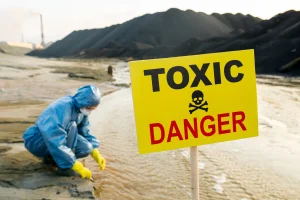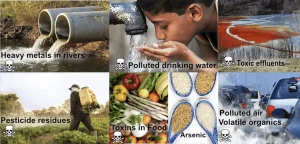Techniques for chemical speciation analysis are essential for understanding the impact of particular chemical species. This helps us protect health, environment and industry.
All naturally occurring metals and metalloids are ubiquitous in at least trace concentrations in soil, water, air, plants and bodily fluids. Most living organisms require some trace levels of various micronutrients such as iron, aluminium, copper, zinc and selenium. However, in certain conditions, these essential elements can accumulate to toxic concentrations, which has significant implications for the environment and for human, animal and plant health.
Regulatory bodies impose limits on the legal concentration of elements in an attempt to protect the environment, ecosystem and health. Scientific studies (e.g. Adamu et al, 2013) suggest that it is more important to consider the concentrations of particular species rather than the overall concentration of the element. This is because speciation determines a chemical’s toxicity and bioaccessibility and therefore its implications for health. (See our article on ‘Chemical Speciation’ for more detail.)
Here, we look at some case studies to illustrate the impact of chemical speciation.
1. Erin Brockovich

Erin Brockovitch
In the 2000 biographical movie Erin Brockovich, the title character, played by Julia Roberts, takes on US corporate giant PG&E (Pacific Gas & Electric Company) in a legal battle which aims to hold the company accountable for the poor health of the residents of Hinkley, CA, caused by contaminated water discharged from 1952 to 1972 into unlined pools which then leaked into groundwater aquifers. She finds incriminating measurements of chromium in local water wells, discovering that PG&E is polluting the town’s drinking water with Cr(VI) concentrations at least 10 times higher than the CA’s 1977 regulation of 50 parts per billion (ppb).
The US Environment Protection Agency has a legal limit for total chromium concentration in water of 100 ppb. However, the true severity of PG&E’s threat to human health is revealed when the concentration of the carcinogenic species of chromium, Cr(VI) was investigated. It was the chemical speciation data that allowed the prosecutors to expose the precise health risk to residents caused by Cr(VI), rather than total chromium concentration data. This led to a $333m settlement payment in 1996 and an intense clean-up project.
Cr(III) is relatively benign compared to Cr(VI) so clean-up efforts focusing particularly on Cr(VI) contamination address the most dangerous pollution. Furthermore, speciation analysis means that the most effective clean-up techniques can be used, based on the properties of the dangerous species. In 2016, it was reported that there had been a 46% reduction in the plume size of the Cr(VI) contamination in Hinkley, CA. However, the full chemical remedial process is projected to last another four decades.
2. Rhandirmwyn, Wales
An investigation into local water pollution caused by mining in Rhandirmwyn, Wales, is another example of chemical speciation analysis being used to inform risk analysis and response.
Laboratory analysis of river water found elevated levels of the lead species anglesite (a lead sulphate mineral, PbSO4). Anglesite is more soluble than other species of lead, so is more accessible to living organisms. This means it poses a greater threat to the environment.
Having a complete speciation analysis allowed investigators assess the potential impacts of lead on the ecosystem and guided plans for its treatment.
3. Alpine ice
Speciation analyses can also be used to monitor the presence of dangerous species in an area over time as new sourcesof chemical pollution are introduced.

Alpine ice
In 1965, high concentrations of organolead species (such as trimethyllead, dimethyllead and triethyllead) were detected in Alpine snow and ice. This has been linked to the opening of Mont Blanc highway tunnel in July of the same year. An increase in traffic through the Alpine region correlated with a rise in leaded gasoline consumption and associated emissions, which introduced higher lead concentrations to the environment. Following prevalent lead speciation analyses, the majority of countries have banned leaded fuels. This implies that species monitoring can have a crucial influence on policy.
4. Metallomics

Metallomics Research
Public health risk can also be evaluated through the study of metallomics. This involves determining the concentrations of different species of trace metals which interact with biomolecules such as proteins, sugars and DNA fragments.
Protein function, for example, is often critically dependent on the presence of particular metals, such as copper or zinc. Examination of the distribution of metal species in human cells can help us understand their effects on our bodies. Speciation analysis of metals across a range of biomolecules would also help explain how organisms uptake and process (e.g. in transportation, metabolism and detoxification) different species.
New, more efficient and more cost-effective speciation analysis techniques are essential for improving the protection of environmental and public health against toxic chemical species. Nanolyse Technologies Ltd is committed to developing these kinds of techniques.
Please cite this article as: “Matt Randall, Bàrbara Levering and Juliet Martin (2020),The Impact of Chemical Speciation: Health, Environment and Industry. Nanolyse Technologies, Oxford, UK.”
Further Reading
- Jitaru, P., & Barbante, C. (2006). Elemental speciation analysis, from environmental to biochemical challenge. Journal de Physique, 139, 269–294. https://doi.org/10.1051/jp4:2006139019
- Adamu, H., Luter, L., Lawan, M. M., & Umar, B. A. (2013). Chemical Speciation : A Strategic Pathway for Insightful Risk Assessment and Decision Making for Remediation of Toxic Metal Contamination, 2(3), 92–99. https://doi.org/10.5539/ep.v2n3p92




